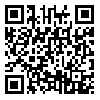Volume 10, Issue 1 (Spring 2024)
JMIS 2024, 10(1): 68-81 |
Back to browse issues page
Download citation:
BibTeX | RIS | EndNote | Medlars | ProCite | Reference Manager | RefWorks
Send citation to:



BibTeX | RIS | EndNote | Medlars | ProCite | Reference Manager | RefWorks
Send citation to:
Tavakoli P, Bagherian H, Isfahani S S, Jangi M. Identifying the Features of Augmented Reality Based Applications for Teaching Clinical Coding. JMIS 2024; 10 (1) :68-81
URL: http://jmis.hums.ac.ir/article-1-488-en.html
URL: http://jmis.hums.ac.ir/article-1-488-en.html
Department of Management and Health Information Technology, School of Management and Medical Information Sciences, Isfahan University of Medical Sciences, Isfahan, Iran.
Abstract: (2464 Views)
Objective: Augmented reality (AR) is one of the new technologies that is used in education, especially medical education. This study aims to determine the requirements for developing an educational application based on AR for teaching clinical coding.
Methods: In this descriptive-comparative study conducted in 2022, we first investigated the user interface (UI) and functionality of the AR-based educational applications. The UI features were extracted from 12 similar applications in Persian and English available in Google Play and Cafe Bazaar. To determine the functionality features, the opinions of a panel of experts including professors of clinical coding from Isfahan University of Medical Sciences in Iran were used.
Results: The UI features included search (found in 3 applications), scanners (found in 11 applications), educational content classification (found in 9 applications), audio/text guides (found in 9 applications), and about us (found in 8 applications) sections. The functionality features included testing of knowledge and using images (2D, 3D).
Conclusion: Due to the theoretical and practical nature of the clinical coding course, a section to solve clinical coding scenarios is an important feature of AR-based educational applications for clinical coding. Also, the use of images (2D, 3D) in these applications can create a deeper impact on students’ learning.
Methods: In this descriptive-comparative study conducted in 2022, we first investigated the user interface (UI) and functionality of the AR-based educational applications. The UI features were extracted from 12 similar applications in Persian and English available in Google Play and Cafe Bazaar. To determine the functionality features, the opinions of a panel of experts including professors of clinical coding from Isfahan University of Medical Sciences in Iran were used.
Results: The UI features included search (found in 3 applications), scanners (found in 11 applications), educational content classification (found in 9 applications), audio/text guides (found in 9 applications), and about us (found in 8 applications) sections. The functionality features included testing of knowledge and using images (2D, 3D).
Conclusion: Due to the theoretical and practical nature of the clinical coding course, a section to solve clinical coding scenarios is an important feature of AR-based educational applications for clinical coding. Also, the use of images (2D, 3D) in these applications can create a deeper impact on students’ learning.
Type of Study: Research |
Subject:
Special
Received: 2023/12/19 | Accepted: 2024/03/12 | Published: 2024/04/1
Received: 2023/12/19 | Accepted: 2024/03/12 | Published: 2024/04/1
Send email to the article author
| Rights and permissions | |
 |
This work is licensed under a Creative Commons Attribution-NonCommercial 4.0 International License. |








 hums.ac.ir
hums.ac.ir